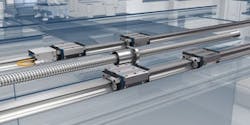- Smooth driving with linear motion
- Point-to-point acceleration with linear motion
- How to actuate in dirty, wet environments
- New innovations in linear motion
What can I do with software or hardware to make my linear motion application faster when moving point to point?
Julius Rurangirwa is Etel motion systems applications engineer at Heidenhain.
Ball screws with driven nuts are a good alternative, offering precision positioning while at the same time eliminating the critical speed concerns that typically limit a more traditional screw-driven configuration.
For linear guides, manufacturers offer varying degrees for speed performance. Look for models that will meet the application criteria—for example, cam roller linear guides offer lower load, but higher speed capabilities, up to 10 m/s. Profiled rail systems, often referred to as square rail, ball rail or roller rail, typically offer a very wide range of performance options and sizes.
Regarding software, using today’s advanced controls, motors controlling linear motion can be precision-tuned for maximum performance. For example, controls can use a high-speed Sercos servo control loop to precisely control motion while maximizing performance.
Figure 1: Integrated linear measurement/scale system with ball screw and roller rail linear guide adds precision and Industry 4.0 capability to linear motion systems.
(Source: Bosch Rexroth)
Speed, acceleration and positon can easily be controlled in varying process conditions. The best controls offer auto-tuning, a built-in drive feature that handles many applications. They also allow custom tuning to be easily performed for highly dynamic systems that require optimized motion.Motion system designers should look for controls that include algorithms within the software to handle maximum loads, maximum accelerations and maximum torques of a linear axis, while maintaining maximum repeatability.
If your motion technology supplier offers both mechanical and electrical motion components, often the control software can automatically identify the connected motors and allow easy pairing and integration of mechanical components.
Most importantly, make sure to take advantage of the knowledge and expertise of your linear-motion-system suppliers. Hardware and software are frequently upgraded to enhance performance, as well as Industry 4.0 connectivity (Figure 1).
Clint Hayes is product sales manager, linear motion technology at Bosch Rexroth.
Chris Bullock is applications engineer I at Bishop-Wisecarver Group.
On the software side, there are a lot of good tools out there to help with motor and gearbox sizing using system analysis. There are also great tools for safety-related functions, a big one being Sistema. These tools, if used correctly, can save a lot of time when designing a system to make sure all the component sizing makes sense for the application and that all the correct safety features are in the design to minimize the risk level of a machine.
As with all technology, the software side of driving linear motion is moving forward in leaps and bounds each year. Controls and drives are faster than ever, making the systems they drive even faster. The limitations with most systems now are the mechanical components, where 15 years ago the controls couldn’t work fast enough to touch the capacity of the mechanical components.
Broc Grell is applications engineer at Nexen Group.
Josh Teslow is applications engineer at Curtiss-Wright.
Another way to optimize time when moving point-to-point is to size the servo drive/motor with respect to the peak operating conditions for faster peak speed acceleration and decelerate only right at the end of the move. By optimizing the servo system like this, a trapezoidal profile can be used to move the mechanical system at peak speed for a longer time achieving a faster overall move time.
Aaron Dietrich is director of marketing at Tolomatic.
Matt Prellwitz is motion product specialist at Beckhoff Automation.
Brian Zlotorzycki is Etel motors product specialist at Heidenhain.
Regarding hardware, the elimination of inertia and friction will yield the greatest gains. Linear motors make for an efficient system as the rotary components are removed (motor rotor, screw, pulleys, belts etc.). Much higher rates of acceleration, deceleration and top speeds can be achieved. However, consider the environmental conditions and packaging design of the motor.
Jay Johnson is national product manager at Sick.
ALSO READ: Putting Linear in Motion
About the Author
Mike Bacidore
Editor in Chief
Mike Bacidore is chief editor of Control Design and has been an integral part of the Endeavor Business Media editorial team since 2007. Previously, he was editorial director at Hughes Communications and a portfolio manager of the human resources and labor law areas at Wolters Kluwer. Bacidore holds a BA from the University of Illinois and an MBA from Lake Forest Graduate School of Management. He is an award-winning columnist, earning multiple regional and national awards from the American Society of Business Publication Editors. He may be reached at [email protected]

Leaders relevant to this article:











